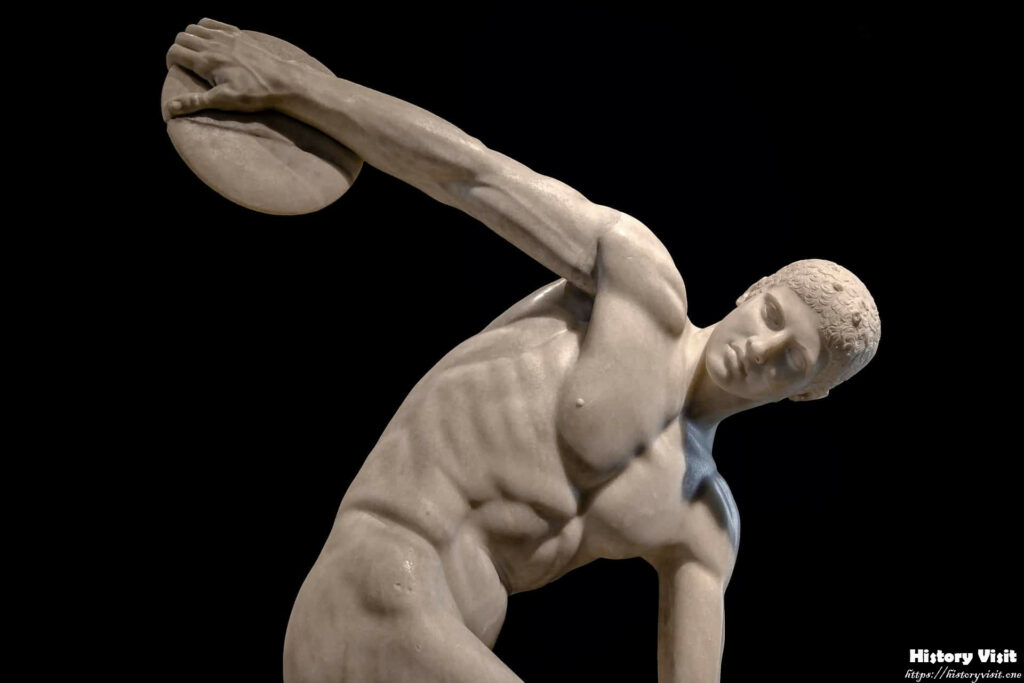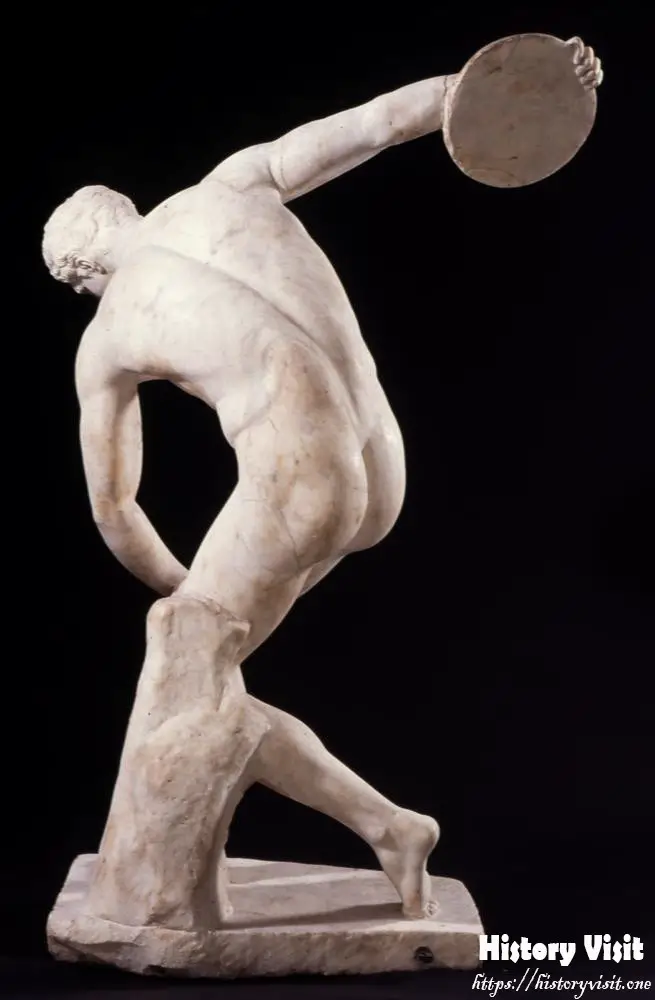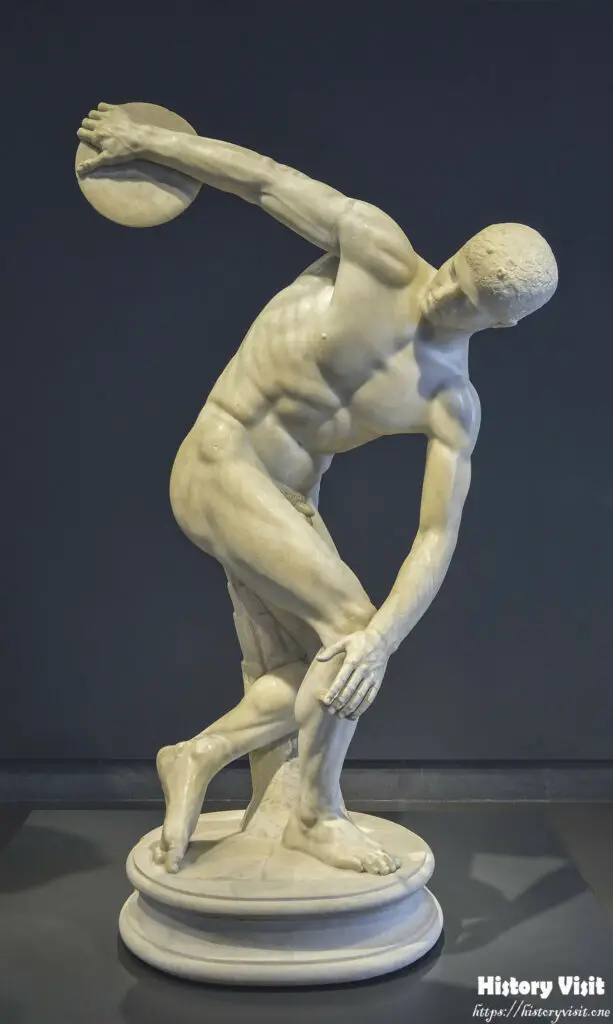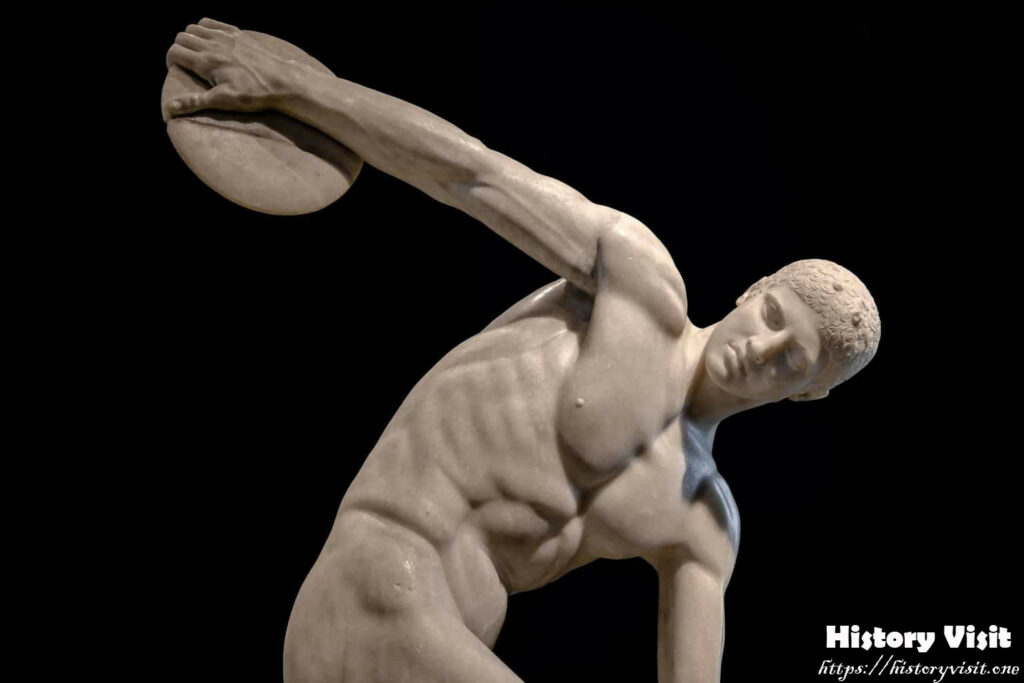Eternal Motion: The Legacy of Myron’s Discobolus through Roman Copies

Introduction
Myron’s Discobolus, an iconic representation of athletic prowess frozen in time, stands as a testament to the enduring legacy of ancient Greek sculpture. Crafted around 450 BC, this masterpiece by the renowned sculptor Myron captures the fluidity and grace of a discus thrower in the midst of his motion. While the original sculpture has been lost to the sands of time, its legacy lives on through multiple Roman copies, with the most famous residing in the National Museum of Rome, Italy. These copies not only preserve the essence of Myron’s vision but also provide valuable insights into the artistic and cultural exchanges between ancient Greece and Rome.
Myron, a celebrated sculptor of the High Classical period, was known for his ability to capture dynamic movement and lifelike anatomy in his works. The Discobolus, one of his most renowned creations, exemplifies his mastery of form and composition. In ancient Greece, athleticism and physical prowess were highly esteemed, and the discus thrower served as a symbol of these virtues. Myron’s sculpture, with its intricate details and naturalistic depiction, encapsulated the spirit of athletic competition and embodied the idealized human form.
Roman artists, enamored by the beauty and sophistication of Greek art, sought to replicate and reinterpret these masterpieces for their own audiences. The Roman copies of Myron’s Discobolus, created during the Imperial period, reflect the admiration and emulation of Greek artistic traditions. Through meticulous craftsmanship and skillful adaptation, Roman sculptors preserved the essence of Myron’s original work while infusing it with their own cultural sensibilities. These copies not only served as decorative ornaments but also as symbols of prestige and sophistication in Roman society.
Myron’s Discobolus: Origin and Inspiration

Myron, a sculptor hailing from the bustling city of Athens during the 5th century BC, was revered for his ability to capture the essence of movement and emotion in his works. Born into an era marked by artistic innovation and intellectual flourishing, Myron’s sculptures embodied the ideals of balance, harmony, and proportion that defined the Classical period. Among his numerous creations, the Discobolus emerged as an enduring symbol of athletic prowess and physical beauty.
The inspiration for Myron’s Discobolus likely stemmed from the ancient Greek tradition of athletic competitions, particularly the Olympic Games. In ancient Greece, athleticism was not merely a pastime but a sacred pursuit that celebrated the perfection of mind and body. The discus thrower, with his poised stance and concentrated gaze, epitomized the idealized athlete who possessed strength, agility, and grace. Myron’s sculpture captured the fleeting moment of kinetic energy as the athlete prepared to release the discus, immortalizing the beauty of human movement in stone.
Roman Copies: The Journey of Replication

The Roman fascination with Greek art and culture reached its zenith during the Imperial period, as the vast expanse of the Roman Empire facilitated the exchange of ideas, goods, and artistic styles. Greek sculptures, revered for their aesthetic beauty and cultural significance, were eagerly sought after by Roman patrons and collectors. To meet the demand for these coveted artworks, Roman artists began creating copies and adaptations of Greek masterpieces, including Myron’s Discobolus.
The process of replicating Greek sculptures involved meticulous observation, skilled craftsmanship, and technical proficiency. Roman sculptors carefully studied the proportions, anatomical details, and artistic techniques employed by their Greek predecessors, striving to emulate their mastery while adding their own creative flair. While some copies remained faithful to the original composition, others underwent subtle modifications to suit the tastes and preferences of Roman patrons. These copies were produced using various materials, including marble, bronze, and terracotta, with each medium offering its own unique challenges and opportunities for artistic expression.
The National Museum of Rome’s Discobolus: A Masterpiece Rediscovered

The National Museum of Rome, located in the heart of the ancient city, houses an unparalleled collection of Roman antiquities, including several notable copies of Greek sculptures. Among these treasures, the Discobolus stands out as a masterpiece of ancient art, captivating visitors with its timeless beauty and dynamic presence. Believed to be a Roman copy of Myron’s original sculpture, the Discobolus exemplifies the enduring appeal and cultural significance of ancient Greek athletics.
The history and provenance of the National Museum of Rome’s Discobolus trace back to the archaeological excavations of the 19th and 20th centuries, during which numerous ancient artifacts were unearthed from archaeological sites across Italy. The discovery of Roman copies of Greek sculptures, including the Discobolus, provided valuable insights into the artistic techniques and aesthetic preferences of ancient Rome. Today, the Discobolus remains one of the museum’s most prized possessions, attracting visitors from around the world who seek to admire its beauty and unravel its mysteries.
Legacy and Influence
The legacy of Myron’s Discobolus extends far beyond the confines of ancient Greece and Rome, inspiring countless artists, athletes, and enthusiasts across the centuries. From the Renaissance to the present day, the Discobolus has served as a symbol of human potential and artistic excellence, transcending cultural boundaries and enduring shifts in artistic taste.
One of the most significant aspects of the Discobolus’s legacy is its profound impact on the development of Western art. During the Renaissance, artists such as Michelangelo and Leonardo da Vinci looked to ancient Greek sculptures, including the Discobolus, as sources of inspiration and models of artistic perfection. The principles of proportion, balance, and idealized form embodied in Myron’s work influenced the artistic techniques and aesthetic sensibilities of the Renaissance masters, shaping the course of Western art for centuries to come.
Beyond its influence on the visual arts, Myron’s Discobolus has also left a lasting mark on the world of athletics and sports culture. The image of the discus thrower, frozen in a moment of dynamic movement and concentration, has become synonymous with the ideals of strength, agility, and determination. Athletes and coaches draw inspiration from the Discobolus’s depiction of physical prowess and strive to embody its spirit of disciplined excellence in their own pursuits.
Moreover, the Discobolus continues to resonate with contemporary audiences as a symbol of timeless beauty and universal significance. Whether viewed in museums, reproduced in artistic renderings, or referenced in popular culture, the Discobolus captivates viewers with its evocative power and aesthetic appeal. Its enduring relevance speaks to the enduring power of art to transcend the limitations of time and space, touching hearts and minds across generations and cultures.
In essence, the legacy and influence of Myron’s Discobolus serve as a testament to the enduring power of artistic expression to inspire, uplift, and unite humanity. As we contemplate this ancient masterpiece, we are reminded of the timeless truths and universal aspirations that connect us across the ages. In a world marked by constant change and uncertainty, the Discobolus stands as a beacon of beauty, strength, and resilience, reminding us of the boundless potential of the human spirit.
Conclusion

In conclusion, Myron’s Discobolus stands as a timeless testament to the enduring legacy of ancient Greek sculpture and its profound influence on Western art, athletics, and culture. Through its Roman copies housed in prestigious institutions like the National Museum of Rome, the Discobolus continues to captivate audiences with its beauty, grace, and timeless relevance.
From the bustling city-states of ancient Greece to the grandeur of the Roman Empire and beyond, the Discobolus has transcended the boundaries of time and space, inspiring generations of artists, athletes, and admirers. Its depiction of athletic prowess and idealized form embodies the timeless aspirations of humanity, reminding us of the enduring quest for excellence and beauty that unites us across cultures and civilizations.
As we gaze upon the Discobolus, we are reminded of the power of art to transcend the limitations of language and culture, speaking to the deepest truths and aspirations of the human spirit. In a world marked by constant change and uncertainty, the Discobolus stands as a symbol of strength, resilience, and timeless beauty, inviting us to contemplate the eternal truths and enduring values that bind us together as a global community.
In the words of the ancient Greek philosopher Plato, “Beauty lies in the eyes of the beholder.” And indeed, as we behold the Discobolus, we are invited to glimpse the beauty, grace, and perfection that reside within each of us, inspiring us to reach for new heights of creativity, athleticism, and human achievement. As we carry forward the legacy of Myron’s Discobolus into the future, may we continue to be inspired by its timeless beauty and universal significance, striving to embody its spirit of excellence, perseverance, and enduring grace.



Eternal Motion: The Legacy of Myron’s Discobolus through Roman